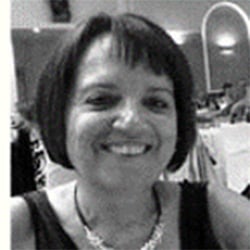Meet The Experts on ClearLLab LS Lymphoid Screen Antibody Panel
Dr. Michael Kapinsky, one of Beckman Coulter’s clinical flow cytometry experts, and Dr. Katherina Psarra from the Immunology Dept. at Evangelismos Hospital, Athens, answer your questions on the ClearLLab LS Lymphoid Screen antibody panel. The panel was the first CE-IVD marked 10-color assay for leukemia and non-Hodgkin’s lymphoma analysis.

Dr Katherina Psarra
Dr Psarra received her Chemistry undergraduate degree from Kapodistrian University of Athens, her Clinical Biochemistry MSc from University of Newcastle upon Tyne, UK after which she returned to Medical School of Kapodistrian University of Athens to complete her Ph.D. in Immunology. Since 1983 Dr Psarra has been working at the Immunology-Histocompatibility Department, Evangelismos Hospital, Athens, where she has been instrumental in developing the flow cytometry laboratory and its application across the routine clinical settings of immunology, haematology, oncology, gynaecology, infections and neurology. Dr Psarra is currently President of the European Society for Clinical Cell Analysis (ESCCA) and served as past Board member. Dr Psarra is founding member and President of the Hellenic Society of Cytometry and served as past board member and treasurer. She has also served as president for the Greek Society of Clinical Chemistry / Clinical Biochemistry and was actively involved in the organization of many Panhellenic and European congresses. Dr Psarra’s combined deep experience in the application of flow cytometry in the routine clinical laboratory, development of educational programmes and approach to standard practices is unique. She has participated as a writer in publications in many international and Greek scientific journals and books.

Michael Kapinsky
Dr. Kapinsky started his academic education in classical chemistry before his scientific ambitions migrated towards life sciences. After a short excursion to plant biochemistry, he spent 4 years doing research in the field of atherosclerosis, and received a Ph.D. from Regensburg University in 2002. During his experimental work, Michael utilized flow cytometry to characterize an in-vitro model of macrophage-derived foam cell formation, and to analyze the related functional significance of cholesterol-enriched membrane raft structures and localized receptors. In 2002 he joined Beckman Coulter’s flow cytometry division as an applications specialist with responsibilities in Germany and Switzerland. Beginning in 2012, Michael assumed a role as applications specialist in the global flow cytometry team at Beckman Coulter. In 2013 he joined BC’s Cytometry Business Unit as product manager for cytometry reagents and applications, migrating to a global role as senior strategic marketing manager for flow cytometry reagents.
Can we expect equal performance characteristics for the dry antibody panel as from liquid antibodies?
Yes. We have never observed a difference in the performances between dry antibodies and the liquid antibodies that were used to generate the dry antibody cocktails, so they are equivalent.
Regarding the dry format of the antibody panel, does this mean that the antibodies are lyophilized?
No. Lyophilization is also a dry format, but it would generate a kind of powder, so you would have small particles in your reagent tube. In contrast, the ClearLLab tube is a dry format that more closely resembles a glass layer that is firmly attached to the bottom of the tube. This provides a few benefits: there are no issues with particles sticking to the tip used to add sample to the ClearLLab tube, and no particles stick to the walls of the tube. This firmly attached layer cannot be removed from ClearLLab assay tubes, making them extremely easy to handle.
For the ClearLLab tube why not use the CD38 APC instead of the CD34 APC?
It depends on what you want to achieve by adding this marker. CD34 is a highly specific marker that ensures you can see any progenitor entities in the tube. While CD38 may also do this, it will not be as specific. It is also an activation marker that is expressed on all kinds of leukocytes. CD34 ensures immature progenitor-like cellular entities are not missed.
Using the dry ClearLLab panel, how is the staining procedure different from working with liquid antibodies?
In principle, the staining procedure is the same. You treat the sample the same way for Kappa Lambda detection. The sample is pre-washed to remove the soluble immunoglobulins, but then you directly add the sample to the tube, which is a minor difference. With liquid antibodies, you pool your antibodies first and create your homebrew mix by pipetting the single-color antibodies. ClearLLab eliminates this entire procedure. After adding the sample, the workflow is identical. This is a classic protocol, however there is no antibody pipetting when using the ClearLLab tube, which reduces the potential for human error, such as using the wrong volume, forgetting to add an antibody, or adding an antibody that should not be in there.
How long will samples stay stable, and is there any difference in sample stability between the two reagents?
There is no difference regarding sample stability. Samples should not be older than one day (24 hours), and prepared samples should be measured the same day. The only differences arise in the workflow, and that the antibody panel has been optimized for different fluorochromes and donors.
To ensure maximum cell recovery, how many wash steps do you recommend for the Kappa Lambda staining with ClearLLab reagents?
We recommend three wash steps. Typically, you should be good with two wash steps. You can increase the efficiency of the wash step by aspirating the supernatant instead of trying to decant it. In general, this does not deliver the same washing effect, however, so we recommend aspirating the sample and using three washing steps to deliver optimal results.
Can ClearLLab tubes be stored or exposed to daylight or typical laboratory lights?
No. ClearLLab reagents are stable at room temperature, but as with all fluorochromes, they must be stored in the dark. ClearLLab tubes include fluorochromes that are excited by light to emit fluorescence, but during that process, there would be a certain portion of loss of energy during other pathways, and this could also be what we call a fleeting photo-oxidation of the dyes. For maximum convenience, ClearLLab tubes come in a light-safe, easy-to-close pouch. Users can remove the number of tubes needed and then close the pouch again to protect the remaining tubes from sunlight.
What is the minimum cell quantity per tube required for optimal results?
Sometimes you will have certain limitations due to the nature of the sample. If you have lymphopenic samples, it might be difficult to get good displays of each population. To ensure a meaningful result, even with lymphopenic samples, try to get at least 20,000 - 25,000 leukocytes. Statistically, any population that you want to quantify should contain at least 100 events.
Is compensation setup as standardized as this dry panel shows?
The instrument setup is based on calibration with beads. The calibration involves a light signal going into the instrument and the detectors deliver a defined signal on each of the scales. There is a Compensation kit available from Beckman Coulter to order with the ClearLLab LS that contains all the colors in single color tubes to run your standard automated compensation.
Can a fixative reagent be used with a ClearLLab system?
That should not be excluded. When testing a ClearLLab tube in clinical studies, it is important to follow the procedure described in the instructions for use (IFU). If desired, you can qualify a certain fixation procedure with ClearLLab for use in your own lab, but Beckman Coulter guarantees ClearLLab only for use as defined in the IFU.
You stated that it is an IVD (invitro diagnostic) for peripheral blood. However, most of our hematopathology applications used bone marrow aspirates. Is this tube still OK to use for those samples?
Yes. We have routinely used ClearLLab for bone marrow samples, CSF (Cerebral Spinal Fluid) samples and others. The reagent has been qualified and tested for peripheral blood, bone marrow, and lymph nodes. Clinical studies have been conducted on those sample types, and we can guarantee that these materials are suitable for interrogation with the ClearLLab LS tube.
Would you use the orientation tube to check for clinical situations other than the ones you described?
Yes. It is a good orientation tube, for example, to check if the sample you have is Myeloid Dysplastic Syndrome (MDS) or not. It has all the different variables needed for the Ogata score and provides a quick first answer as to whether you should further investigate if this case is an MDS or other hematological malignancy.
In the T lymphoma case, it may express the cytoplasmic CD3. Do you have a dry tube for the detection of this?
No. We do not currently have a dry tube format, but we do have an IVD-cleared procedure with a PerFIX NC reagent that shows detection of cytoplasmic CD3, 79A, TDT and MPO. This, in effect, would be an intracellular lineage tube used to qualify the perfect NC intracellular buffer for diagnostic use, which is what we recommend in that case.

